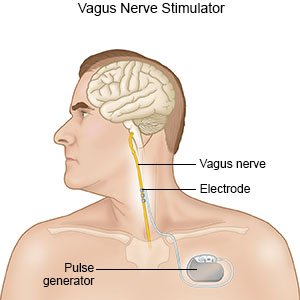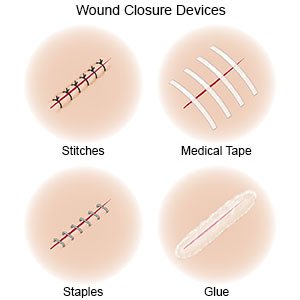Vagus Nerve Stimulation
Medically reviewed by Drugs.com. Last updated on Apr 6, 2025.
What do I need to know about vagus nerve stimulation (VNS)?
VNS is a treatment used for epilepsy and depression. VNS is used when medicines and other treatments have not worked well. VNS may help shorten the recovery time after you have a seizure. VNS may also help decrease symptoms of depression. It may take several months to notice changes in your seizure or depression symptoms.
How does VNS work?
- A device called a pulse generator is used to stimulate the vagus nerve with electrical impulses. You have one vagus nerve on each side of your body. The nerve goes from your brain through your neck to your chest and abdomen. The vagus nerves carry messages from your brain to your organs, such as your heart and lungs. The nerves also carry messages to other parts of your brain that regulate mood, sleep, and other functions.
- The pulse generator device is about the size of a watch face. The device is placed into your chest during surgery. A wire under your skin connects the device to your left vagus nerve. The device is turned on a few weeks after surgery. This gives the surgery area time to heal. The device is powered by a battery that usually lasts about 10 years.
 |
How do I prepare for VNS surgery?
Your healthcare provider will talk to you about how to prepare for surgery. He or she may tell you not to eat or drink anything after midnight on the day of your surgery. He or she will tell you what medicines to take or not take on the day of your surgery. You may be given an antibiotic through your IV to help prevent a bacterial infection. Arrange to have someone drive you home.
Drugs used to treat this and similar conditions
Keppra
Keppra is an anti-epileptic drug used to treat partial onset seizures in people with epilepsy ...
Onfi
Onfi (clobazam) is used to treat seizures associated with Lennox-Gastaut syndrome, a form of ...
Ozempic
Learn about Ozempic (semaglutide) for type 2 diabetes treatment, weight management, cardiovascular ...
Ativan
Ativan is a benzodiazepine used to treat anxiety disorders or anxiety associated with depression ...
Banzel
Banzel (rufinamide) is used in combination with other medications to treat adults and children with ...
Epidiolex
Epidiolex (cannabidiol) is an oral prescription liquid CBD medicine that may be used to treat ...
Xcopri
Xcopri (cenobamate) is an oral, once-daily, tablet that may be used to treat partial-onset seizures ...
Vimpat
Vimpat is used to treat partial onset seizures and primary generalized tonic-clonic seizures in ...
What will happen during VNS surgery?
- You may be given general anesthesia to keep you asleep and free from pain during surgery. You may instead be given local anesthesia to numb the surgery area. With local anesthesia, you may still feel pressure or pushing during surgery, but you should not feel any pain.
- Your surgeon will make 2 incisions. One is on your upper left chest or under your arm. The other is on the left side of your neck. He or she will place the stimulator device in your chest. Your surgeon will then guide a wire under your skin from the device to your neck. He or she will attach it to your left vagus nerve through the second incision in your neck. The incisions will be closed with medical glue, tape, or stitches.

What will happen after VNS surgery?
- The device is turned on when you see your surgeon or neurologist for a follow-up visit. This is usually a few weeks after surgery. He or she will program your device to deliver electric impulses to your vagus nerve. The impulses can be set to cycle at different levels, times, and strengths. The impulses usually start at a low level and can be increased gradually if needed.
- You may have symptoms when the impulses are happening. These may include tingling or discomfort in your neck, or a hoarse voice. You will receive a hand-held magnet. This can be used to start the impulse, such as when you sense you are going to have a seizure. The magnet can also be used to turn the device off, such as when you exercise. This is because it may be programmed to detect increased heart rate.
What are the risks of VNS or surgery to place the generator?
You may bleed more than expected or develop an infection. You may have pain or discomfort where the device is placed. You may have an allergic reaction to the device or the wire. You may have pain or feel a shock during stimulation. You may have headaches, tingling on your skin, or trouble sleeping. The wire may move and you may need to have surgery again.
Care Agreement
You have the right to help plan your care. Learn about your health condition and how it may be treated. Discuss treatment options with your healthcare providers to decide what care you want to receive. You always have the right to refuse treatment. The above information is an educational aid only. It is not intended as medical advice for individual conditions or treatments. Talk to your doctor, nurse or pharmacist before following any medical regimen to see if it is safe and effective for you.© Copyright Merative 2025 Information is for End User's use only and may not be sold, redistributed or otherwise used for commercial purposes.
Further information
Always consult your healthcare provider to ensure the information displayed on this page applies to your personal circumstances.
